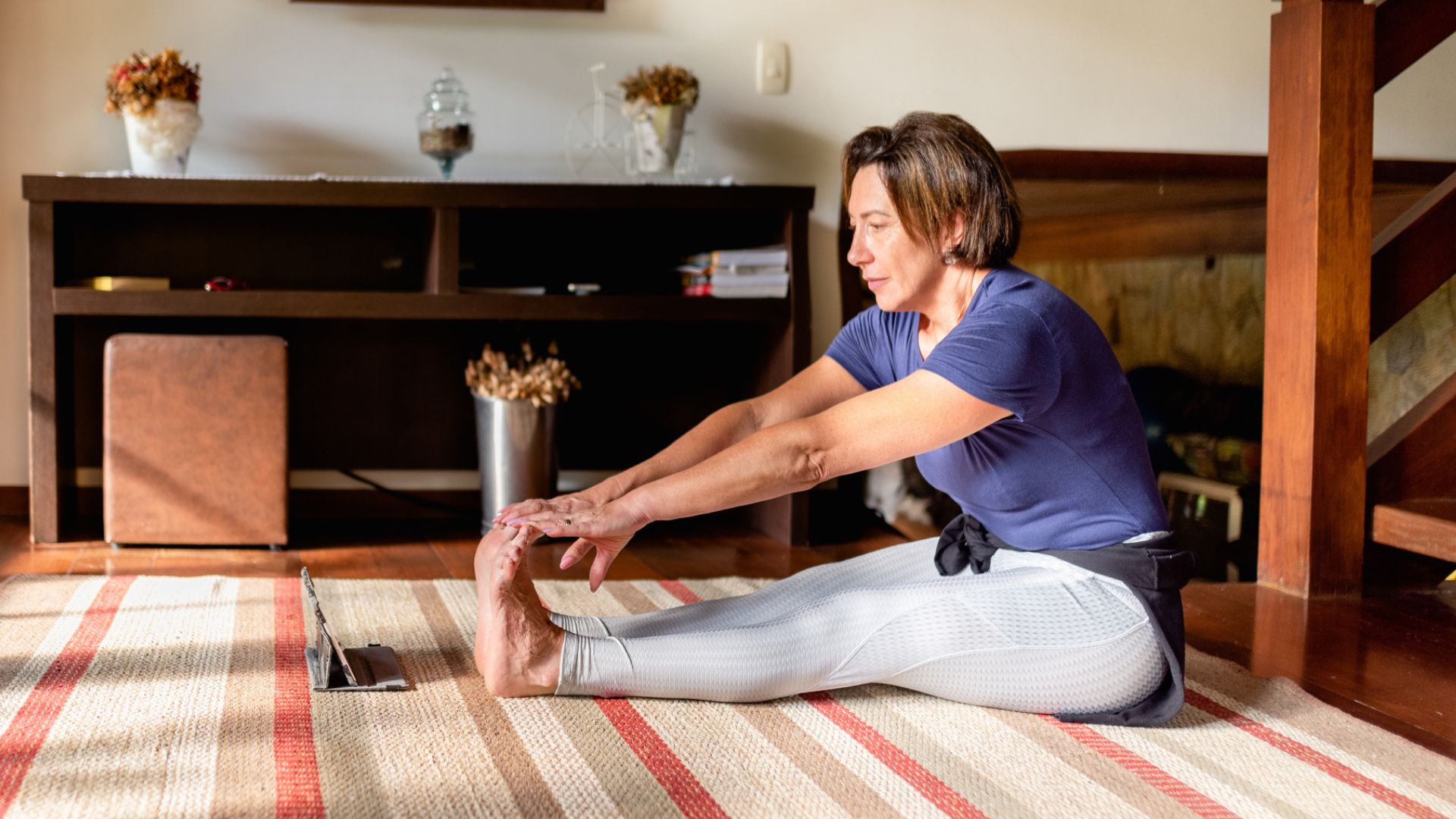I tried doing this simple yoga stretch before bed for a week and my lower back pain has disappeared
I’m a belly sleeper and it’s started to impact my mobility—this move has sorted it out

I feel most comfortable falling asleep on my stomach, despite the fact that experts say that belly sleeping can lead to aches and pains in the back and neck. The problem is, that I find it difficult to drop off on my side or back.
Having recently turned 30, I’m now paying the price for decades of belly sleeping. I’m waking up with lower back pain and I have started feeling a loss of spinal mobility throughout the day.
If it hurts to move in a certain way, I’ve been consciously (and subconsciously) avoiding those movements, which means I’m now less flexible when I do finally try to do them. For example, I’ve found myself less able to pick up items from the floor without squatting down.
The only thing that helps is a stretch called the seated forward fold but I’ve never done it consistently. But as the pain has increased, I decided to do it every day before going to bed.
When to do the seated forward fold
The late timing of the seated forward fold was recommended by April Flood, a physical therapist at Smith Physical Therapy.

Flood has a Bachelor’s degree in Biology and a Doctorate in Physical Therapy from Clarke University in Dubuque, Iowa. She has spent her career working in the outpatient orthopedic field, treating a variety of post-operative and non-operative patients to help them return to their desired activity levels and improve their quality of life.
“It gives the muscles a good stretch and gives them the cue to calm down, so when you roll onto your stomach at night they don’t stay tight and guarded,” she says, explaining that ‘muscle guarding’ is when the surrounding muscles tense to protect a muscle.
“By stretching in a direction that counteracts the positions your spine has been in all day, you give those muscles a chance to relax so they do not stay tight and tense while you are sleeping.”
Start your week with achievable workout ideas, health tips and wellbeing advice in your inbox.
And my aches could be caused by more than sleeping. “Even if you don’t experience low back pain during the day, the cumulative effect of prolonged sitting, or prolonged standing can cause pain by the end of the day,” she says because the spine is being impacted all day.
“With nearly everything we do, our spine is working. It is also not uncommon for people, especially hypermobile people, to stand with their knees locked, which causes a forward tilt at our pelvis and then leads to extension of our spine,” she says. “We may not feel it at that moment, but later that night may be when you feel the effects.”
And the way I sleep compounds the problem. “When we lie on our stomachs we create further extension of our spine,” says Flood. “Those muscles along our spine, called the paraspinals, can get tight. As well as leading to hamstring and glute tightness,”
“Stretching can help promote relaxation and help your parasympathetic nervous system kick in to help you fall asleep.”
With the timing sorted, I just needed to make sure I was doing the move effectively.
I find a full seated forward fold quite difficult to do without some strain, so I turned to personal trainer Jordan Phelps, whose videos offer his clients variations of the move—meaning you can work your way up to the full stretch in three gradual steps.
How to do Jordan Phelps' three-step seated forward fold.
Step 1
- Sit cross-legged.
- Bend forward as much as you can—this may not be much, which is fine.
- Hold the stretch for one minute while taking long breaths to deepen the stretch.
Step 2
- From the cross-legged position, extend one leg and reach towards your foot with the opposite hand.
- Hold for one minute. Take deep breaths and see if you can you reach further on the exhale.
- Repeat on the other side.
Step 3
- Extend both legs and reach towards the feet with both hands (this is your full seated forward fold).
- Try to touch your feet if possible but if you can’t, or if it puts a painful strain on the back, then aim for your calves instead.
- Hold for one minute.
- Aim to reach a little closer to the feet as time goes on.
- If you can reach the feet, aim to bend the elbows and lower the torso closer to the legs.
What I found after doing a seated forward fold every day
I did the seated forward fold before bed every night for a week—without fail, even when I really couldn’t be bothered. It’s such a simple move that I wasn’t expecting huge results in just seven days. Here’s what happened.
Stretching progressively was very helpful
Starting with the cross-legged stretch and slowly progressing to the full forward fold helped me to achieve a deeper stretch. Jumping straight in with a full forward fold, both legs extended, was too intense for me and caused discomfort in my lower back and hamstrings.
When I began by stretching over folded legs, it allowed me to ease down and stretch my muscles more gradually, so that when I did reach the final stretch, it wasn’t uncomfortable. This way I managed to achieve a deeper release in the last pose.
I woke up pain free the first morning
It may seem counterintuitive to stretch before bed instead of first thing when I’m feeling the most pain, but I took Flood’s advice and the timing worked really well for me.
That first morning, I woke up without a stiff lower back for the first time in months. Instead of my usual creaky clamber out of bed, I sat up without the aches and lifted myself up with ease. The pains and aches didn’t return with the same intensity during the day either.
My mobility improved
After a week of stretching before bed, I found that not only was I pain free in the mornings, but my mobility improved too. Twisting, reaching and even lifting something above my head might previously have triggered soreness in my lower back, but now I could move without issues.
I’m not great at sticking to regular stretching, even when it’s helpful, so I’ll aim to do this a few times a week before bed as a preventative measure to keep the lower back pain at bay.
I’m unlikely to adapt to sleeping on my back or side, so having this simple stretch to counteract any issues is great. And if the aches do return, I’ll know it’s time to increase the regularity with which I do it.

Lou Mudge is a Health Writer at Future Plc, working across Fit&Well and Coach. She previously worked for Live Science, and regularly writes for Space.com and Pet's Radar. Based in Bath, UK, she has a passion for food, nutrition and health and is eager to demystify diet culture in order to make health and fitness accessible to everybody.
Multiple diagnoses in her early twenties sparked an interest in the gut-brain axis and the impact that diet and exercise can have on both physical and mental health. She was put on the FODMAP elimination diet during this time and learned to adapt recipes to fit these parameters, while retaining core flavors and textures, and now enjoys cooking for gut health.
You must confirm your public display name before commenting
Please logout and then login again, you will then be prompted to enter your display name.



